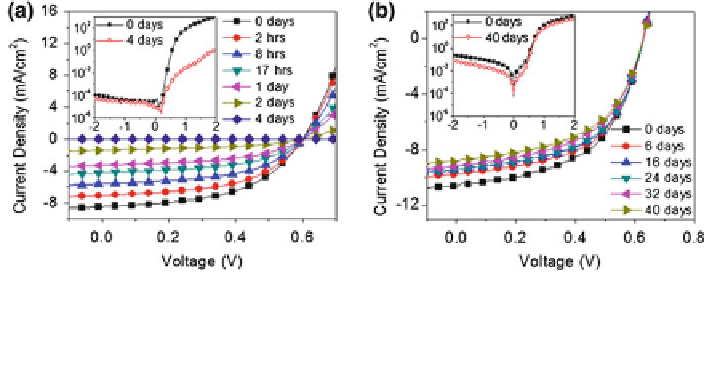Environmental Engineering Reference
In-Depth Information
Cs
2
CO
3
[
77
,
78
]. Large-area inverted devices with ZnO can also be realized by
roll-to-roll processing of each layer [
21
,
79
-
81
].
In principal, the inverted structure offers higher air stability than the normal one
due to relatively stable HWF metal as top anode. Sahin et al. demonstrated a more
air-stable inverted device with a structure of ITO/Perylene/MEH-PPV:PCBM/
CuPc/Au than a normal device [
82
]. The inverted device shows a PCE of 0.14 %
under 74.5 mW/cm
2
illumination in the first day. Although oxygen and humidity
are present, the PCE is decreased by 27 % of the initial value after 2 weeks. On the
contrary, the normal device with LiF/Al as top cathode has a PCE of 1.3 % under
100 mW/cm
2
illumination; however, the efficiency decreases by 91 % after only
1 day during storage in oxygen and diminishes thoroughly after a few days in air.
Hau et al. conducted the air-stability study of inverted devices employing ZnO
nanoparticles (NP) as an electron-transporting layer and PEDOT:PSS/Ag as a
hole-transporting layer and top anode [
83
]. The shelf lifetime is defined as the time
when the PCE drops to half of its initial value. Figure
6.14
a shows the J-V curves
of a normal device of ITO/PEDOT:PSS/P3HT:PCBM/LiF/Al over variable
periods from 0 to 4 days. The results show that the shelf lifetime is only 1 day, and
a complete degradation is followed after 4 days. A large reduction of dark current
at 2 V is observed after 4 days, as shown in the inset of Fig.
6.14
a, suggesting the
increased series resistance to be part of the degradation mechanism. On the other
hand, the inverted device with a structure of ITO/ZnO NP/P3HT:PCBM/PE-
DOT:PSS/Ag without encapsulation exhibits a relatively stable performance
despite being kept in air for a long time. A 20 % decrease of PCE is shown in
Fig.
6.14
b after 40 days. It is interesting that the decrease of dark current after a
long-time storage does not occur.
Similarly, Liu et al. reported the stability improvement of inverted small-
molecule OPVs with a structure of ITO/ZnO/CuPc:C
60
/CuPc/PEDOT:PSS/Ag
[
84
]. The authors compare two measurements for device stability: one is to test
Fig. 6.14 J-V characteristics of unencapsulated a normal device over a period of 4 days and b inverted
device over a period of 40 days in air under ambient conditions. Inset: dark J-V characteristics of the
respective devices [
83
]. (Reprinted with permission from Ref. [
83
]. Copyright [2008], American
Institute of Physics)

Search WWH ::

Custom Search